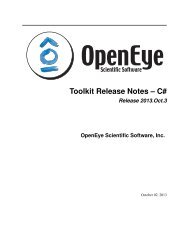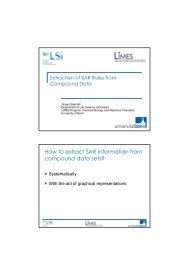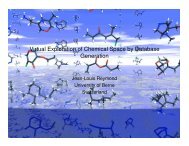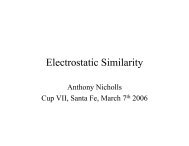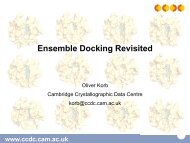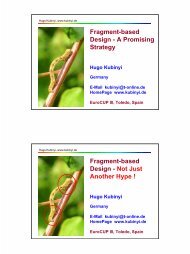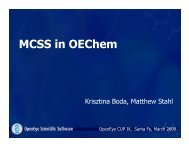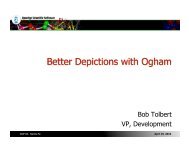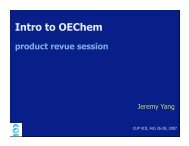pdf 6.58M
pdf 6.58M
pdf 6.58M
Create successful ePaper yourself
Turn your PDF publications into a flip-book with our unique Google optimized e-Paper software.
pK I exp.<br />
10<br />
9<br />
8<br />
7<br />
6<br />
5<br />
4<br />
3<br />
2<br />
AFMoC con : Incorporating ligand<br />
and receptor conformational<br />
variability into tailor-made<br />
scoring functions<br />
Serineproteases<br />
r 2 = 0.85<br />
1<br />
8<br />
1 2 3 4 5 6 7 8 9 10<br />
Holger Gohlke<br />
DrugScore<br />
Frequency<br />
Property<br />
W = -ln[P]<br />
„Potential“<br />
Property<br />
Gohlke, Hendlich, Klebe, JMB 2000.<br />
Predicting binding affinities<br />
pK i calc.<br />
pK i exp.<br />
1adc<br />
Ferrara, Gohlke et al., JMC 2004.<br />
14<br />
12<br />
10<br />
6<br />
Metalloenzymes<br />
r 2 = 0.74<br />
4<br />
14<br />
2<br />
2 4 6 8 10 12 12 14<br />
pK i calc.<br />
• Data sets from LPDB<br />
• Scaling of DrugScore<br />
pK i= c * DrugScore<br />
pK i exp.<br />
10<br />
8<br />
6<br />
4<br />
2<br />
0<br />
0 2 4 6 8 10 12 14<br />
pK i calc.<br />
1ebg<br />
Mixed: r 2 = 0.34<br />
Scoring protein-ligand interactions<br />
Identify binding mode<br />
DrugScore<br />
Prioritize ligands<br />
pK i (calc)<br />
-ln(g(R) / g ref (R))<br />
3<br />
2<br />
1<br />
0<br />
-1<br />
-2<br />
pK i (exp)<br />
Distance-dependent<br />
pair potentials<br />
1 2 3 4 5 6<br />
R [Å] O N<br />
R O O R<br />
R<br />
R<br />
O<br />
O N<br />
R<br />
O O R<br />
Only non-H atoms + Fast +<br />
General applicable + Tolerant against (exp.) errors<br />
Beware of mass dependence<br />
Recalc. with data from<br />
Wang, Lu, Wang,<br />
JMC 2003.<br />
Correlation with<br />
mass of the ligands<br />
R S = 0.56<br />
Velec, Gohlke, Klebe, JMC 2005.<br />
1
Overview<br />
Adaptation of Fields for Molecular Comparison<br />
∑<br />
p∈P<br />
AFMoC<br />
and<br />
Docking<br />
ΔP<br />
= ΔW<br />
)<br />
g , t<br />
t,<br />
Τ(<br />
p)<br />
( rg<br />
, p<br />
AFMoC<br />
and<br />
Conformational<br />
Variability<br />
Predicting ‘hot spots’<br />
Gohlke, Hendlich, Klebe, PD3 2000.<br />
Methods in rational drug design<br />
Candidate<br />
Docking<br />
QSAR<br />
structure-based<br />
information<br />
ligand-based<br />
information<br />
Binding<br />
mode<br />
Binding<br />
affinity<br />
Intrinsic geometrical<br />
information<br />
R<br />
HO<br />
3.45Å<br />
R<br />
2.55Å<br />
O<br />
1.22Å<br />
R<br />
∠(C.2-O.2-O.3) = 128°<br />
Phospholipase<br />
(1poc)<br />
Ca<br />
ISOSTAR<br />
HIV-1 protease<br />
(1hvr)<br />
O.sp2<br />
C.sp3<br />
Tailoring DrugScore towards<br />
one specific protein<br />
O.sp2<br />
O.sp3<br />
C.ar<br />
Goal: Improvement of predictive power for pK i values<br />
Idea:<br />
& &<br />
pK 1<br />
i<br />
pK 2<br />
i<br />
pK i 3<br />
pK i n<br />
2
Approach<br />
“Potential field” * Property = Interaction field<br />
T t<br />
Interaction fields ...<br />
... contain protein information<br />
... are atom-type specific<br />
... are orthogonal<br />
... are „free energy“-fields<br />
AFMoC<br />
Adaptation of Fields for Molecular<br />
Comparison<br />
T 1<br />
Comp. 1,<br />
pK i 1<br />
Comp. n,<br />
pK i n<br />
⎛c1<br />
, Τ ⎞ 1 ⎜ ⎟<br />
⎜ M ⎟<br />
1<br />
1<br />
1<br />
1<br />
⎛<br />
⎞<br />
⎜ ⎟<br />
1<br />
ΔW1,<br />
Τ LΔWg<br />
Τ LΔW<br />
Τ LΔWg<br />
Τ ⎜<br />
cg<br />
Τ ⎟ ⎛ ⎞<br />
⎜<br />
⎟<br />
pK<br />
1<br />
, 1 1,<br />
t<br />
, t , 1<br />
i ⎜ ⎟<br />
⎜M<br />
O<br />
M ⎟ * ⎜ M ⎟ = ⎜ M ⎟<br />
⎜<br />
⎟ ⎜ ⎟<br />
⎜ n<br />
n<br />
n<br />
n ⎟<br />
⎜ n ⎟<br />
⎝<br />
ΔW<br />
Τ LΔWg<br />
Τ LΔW<br />
Τ LΔWg<br />
Τ ⎠<br />
⎜c<br />
1,<br />
1,<br />
Τ ⎟ ⎝ pK<br />
1<br />
, 1 1,<br />
t<br />
, t<br />
t<br />
i ⎠<br />
⎜ ⎟<br />
⎜ M ⎟<br />
⎜ ⎟<br />
⎝<br />
cg<br />
, Τt<br />
⎠<br />
# Unknowns c i,Τj > # Equations<br />
c i,Τj from Partial-Least-Squares analysis<br />
Results of PLS analysis<br />
• Grid width: 1 Å,<br />
Half-width of Gaussian: 0.85 Å<br />
• Fields for:<br />
aliphat. C<br />
aromat. C<br />
hydroxyl-O<br />
carbonyl-O<br />
carboxyl-O<br />
amide-N<br />
mercapto-S<br />
N 61<br />
q 2<br />
sPRESS<br />
r 2<br />
0.62<br />
1.34<br />
0.97<br />
S 0.37<br />
F 166<br />
C om ponents 10<br />
Gohlke, Klebe, JMC 2002.<br />
Approach<br />
Correlation of interaction fields with known pK i values<br />
q 0,4<br />
0,3<br />
2<br />
T t<br />
T 1<br />
Comp. 1,<br />
pK i 1<br />
Comp. n,<br />
pK i n<br />
• 61 Inhibitors for training<br />
⎛c1<br />
, Τ ⎞ 1 ⎜ ⎟<br />
⎜ M ⎟<br />
1<br />
1<br />
1<br />
1<br />
⎛<br />
⎞<br />
⎜ ⎟<br />
1<br />
ΔW1,<br />
Τ LΔWg<br />
Τ LΔW<br />
Τ LΔWg<br />
Τ ⎜<br />
cg<br />
Τ ⎟ ⎛ ⎞<br />
⎜<br />
⎟<br />
pK<br />
1<br />
, 1 1,<br />
t<br />
, t , 1<br />
i ⎜ ⎟<br />
⎜M<br />
O<br />
M ⎟ * ⎜ M ⎟ = ⎜ M ⎟<br />
⎜<br />
⎟ ⎜ ⎟<br />
⎜ n<br />
n<br />
n<br />
n ⎟<br />
⎜ n ⎟<br />
⎝<br />
ΔW<br />
Τ LΔWg<br />
Τ LΔW<br />
Τ LΔWg<br />
Τ ⎠<br />
⎜c<br />
1,<br />
1,<br />
Τ ⎟ ⎝ pK<br />
1<br />
, 1 1,<br />
t<br />
, t<br />
t<br />
i ⎠<br />
⎜ ⎟<br />
⎜ M ⎟<br />
⎜ ⎟<br />
⎝<br />
cg<br />
, Τt<br />
⎠<br />
# Unknowns c i,Τj > # Equations<br />
c i,Τj from Partial-Least-Squares analysis<br />
Thermolysin<br />
• Superimpositioning inside the binding pocket of<br />
thermolysin using crystal structure templates<br />
0,9<br />
0,8<br />
0,7<br />
0,6<br />
0,5<br />
0,2<br />
0,1<br />
Internal validation<br />
Leave-Five-Out<br />
Leave-One-Out<br />
Leave-Five-Out<br />
0,0<br />
0 1 2 3 4 5<br />
run<br />
6 7 8 9 10<br />
Randomly selected pK i’s<br />
# of components<br />
0,0<br />
1 2 3 4 5 6 7 8 9 10<br />
-0,1<br />
-0,2<br />
q -0,3 2<br />
-0,4<br />
-0,5<br />
3
Predictive power by variation<br />
between generality and specificity<br />
• 15 Thermolysin inhibitors for test set<br />
• same treatment as before (“hand-docking”)<br />
r 2<br />
0,8<br />
0,6<br />
0,4<br />
0,2<br />
Original<br />
pair potentials<br />
PLS-model<br />
0,0 0,2 0,4 0,6 0,8 1,0<br />
θ<br />
Predictive power by variation<br />
between generality and specificity<br />
• Mix “general” and “specific” results<br />
pK = ( 1−θ<br />
) pK + θ pK<br />
i<br />
Paar<br />
i<br />
PLS<br />
i<br />
• How much additional<br />
information?<br />
100 times random<br />
choice of<br />
5, 15, 30, 45, 53<br />
training compounds<br />
⇒ PLS model<br />
⇒ prediction<br />
r 2<br />
0,8<br />
0,6<br />
0,4<br />
0,2<br />
0,0 0,2 0,4 0,6 0,8 1,0<br />
θ<br />
61<br />
61<br />
53<br />
45<br />
30<br />
15<br />
5<br />
Predictive power by variation<br />
between generality and specificity<br />
• Mix “general” and “specific” results<br />
pK = ( 1−θ<br />
) pK + θ pK<br />
i<br />
Paar<br />
i<br />
PLS<br />
i<br />
r 2<br />
0,8<br />
0,6<br />
0,4<br />
0,2<br />
Overview<br />
Original<br />
pair potentials<br />
PLS-model<br />
0,0 0,2 0,4 0,6 0,8 1,0<br />
θ<br />
Adaptation of Fields for Molecular Comparison<br />
AFMoC<br />
and<br />
Docking<br />
AFMoC<br />
and<br />
Conformational<br />
Variability<br />
A tailor-made objective function A tailor-made objective function<br />
AFMoC obj<br />
61<br />
4
Docking HIV-1 protease inhibitors<br />
# Complexes<br />
60<br />
50<br />
40<br />
30<br />
20<br />
10<br />
• 66 complexes from<br />
the PDB<br />
• 48 compounds for<br />
training<br />
q 2 of the model > 0.6<br />
• Consensus docking:<br />
target structure 1ajv<br />
• Docking using<br />
AutoDock<br />
Radestock, Böhm, Gohlke, JMC 2005.<br />
Binding mode predictions<br />
0<br />
0 1 2 3 4 5 6<br />
rmsd [Å]<br />
AFMoC<br />
*<br />
obj<br />
DrugScore<br />
AutoDock<br />
improvement<br />
14%<br />
train and test<br />
data perform<br />
equally well<br />
Exploring new interactions<br />
DrugScore: 4.5 Å rmsd<br />
Fields for aliphatic C (C.3)<br />
AFMoC obj : 0.8 Å rmsd<br />
Processing of the fields<br />
1. Column filtering<br />
2. Remove repulsion<br />
3. Mixing<br />
“standard” PLS<br />
PLS with Shannon<br />
entropy based filtering<br />
Accentuate important regions<br />
DrugScore: 2.2 Å rmsd<br />
Fields for hydroxyl O (O.3)<br />
AFMoC obj : 1.4 Å rmsd<br />
Further benefits from AFMoC obj<br />
• Implicit consideration of multiple solvation<br />
schemes<br />
“flap water” absent “flap water” present<br />
5
Binding affinity predictions<br />
… in a multistep approach using AFMoC<br />
Method<br />
AFMoC obj<br />
DrugScore<br />
AFMoC<br />
r 2<br />
0.27<br />
0.13<br />
0.38<br />
Recipe:<br />
1. AFMoC obj for binding mode detection<br />
2. AFMoC on „good“ modes for affinity prediction<br />
Motivation: Use AFMoC on<br />
homology models<br />
Structure q 2 rmsd [Å]<br />
Exp. 0.57 -<br />
HM1 0.61 1.48 (2.90)<br />
HM2 0.42 1.10 (2.35)<br />
HM3 0.39 1.44 (3.37)<br />
Exp.<br />
HM1 HM2 HM3<br />
60 loop<br />
Approach I: Extended X-Matrix<br />
⇒ Multimode binding<br />
Overview<br />
Adaptation of Fields for Molecular Comparison<br />
AFMoC<br />
and<br />
Docking<br />
AFMoC<br />
and<br />
Conformational<br />
Variability<br />
Idea: Inclusion of receptor and<br />
ligand flexibility<br />
+ + +<br />
Consensus-Model<br />
Consensus Model<br />
Approach I: Extended X-Matrix<br />
• „Obvious“ treatment<br />
→ „Weighted fields approach“<br />
→ ln K i = Σ w j ln K ij<br />
→ K i = Π K ij wj WRONG!<br />
• Right treatment<br />
→ „Multimode binding approach“<br />
→ K i = Σ K ij<br />
→ Requires iterative solution of QSAR equation<br />
Lukacova & Balaz, JCICS 2003<br />
6
Approach II: Variable-Selection<br />
Combination of multiple models<br />
Models HM 1+2 HM 1+3 HM 2+3 HM 1+2+3<br />
w/o varselect.<br />
q 2 0.59 0.45 0.42 0.57<br />
w/ varselect.<br />
q 2 0.61 0.56 0.43 0.60<br />
r 2 (test set) 0.64 0.61 0.41 0.64<br />
Preval. 1 2 1 3 2 3 1 2 3<br />
(Exp.: q 2 = 0.57; r 2 = 0.65)<br />
0.50 0.50 0.50 0.50 0.51 0.49 0.38 0.33 0.29<br />
Overview<br />
con<br />
Breu, Silber, Gohlke, JCIM 2007.<br />
Adaptation of Fields for Molecular Comparison<br />
AFMoC<br />
and<br />
Docking<br />
Where to from here?<br />
AFMoC<br />
and<br />
Conformational<br />
Variability<br />
Validation: Thrombin inhibitors<br />
Structurally diverse<br />
ligand set<br />
Graphical<br />
interpretation<br />
Aromatic carbon<br />
Exp. 1 / 2 / 3<br />
1 + 2 + 3<br />
If the protein moves …<br />
„… deform binding pocket region accordingly“<br />
7
Potential fields as elastic bodies<br />
Problem: Determine displacement components<br />
under prescribed forces<br />
Solution: Elasticity theory via<br />
Navier‘s equation<br />
2 v<br />
v v<br />
μ∇<br />
u + ( μ + λ)<br />
∇Div<br />
u + F = 0<br />
Limiting conformational space<br />
HIV-1 Protease<br />
re: 0.30 Å<br />
apo: 3.86 Å<br />
def: 0.91 Å<br />
- apo<br />
- deformed<br />
Repulsive fields of aromatic carbon<br />
Elastic, adaptive potential grids<br />
Kazemi, Krüger, Sirockin, Gohlke, ChemMedChem 2009.<br />
Mimicking sidechain movement<br />
CAPK<br />
re: 0.33 Å<br />
apo: 3.05 Å<br />
def: 0.75 Å<br />
- apo<br />
- deformed<br />
Scope and limitations Summary<br />
Attractive fields of aromatic carbon<br />
PHE122<br />
- apo<br />
- holo<br />
• AFMoC incorporates additional structural and<br />
energetic information about already known<br />
ligands<br />
• Binding-mode predictions can be improved<br />
using AFMoC obj<br />
• Conformational variability can be considered<br />
using AFMoC con<br />
• Possibility to mix adapted and original fields<br />
• Implicit consideration of multiple solvation<br />
schemes<br />
8
Acknowledgements<br />
• Sebastian Radestock<br />
• Benjamin Breu<br />
• Markus Böhm (Pfizer)<br />
• Hans Velec (Marburg)<br />
• Katrin Silber<br />
• Gerhard Klebe<br />
• DFG<br />
• HWP/FIAS/FIGSS/OSS<br />
• Merck, Darmstadt<br />
• Boehringer, Biberach<br />
• Novartis, Basel<br />
9



